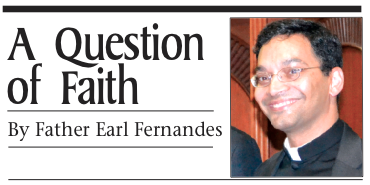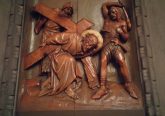Q&A: You may stand or kneel to receive communion
Dear Father: I’m a “southerner” as far as the Archdiocese of Cincinnati is concerned and at a recent visit to a northern area parish I observed an unfamiliar custom. The faithful receiving communion often knelt before the priest and received on the tongue. What does the church say about this and how are we to receive Communion? Why does it seem more common in our northern areas and not down near Cincinnati?
Dear Reader: Thank you for your question. I suspect that you are a younger reader as older Catholics will remember receiving Communion only on the tongue while kneeling. For many people and in many countries, this practice is not so unfamiliar. In some countries, Communion in the hand is not permitted, but it has been permitted in the United States for more than 35 years. The Congregation for Divine Worship issued a response in 1969, when requests were beginning to be made for Communion in the hand, noting that the “new manner of giving communion must not be imposed in a way that would exclude the traditional practice.” The condition under which an indult for Communion in the hand was granted was “complete avoidance of any cause of the faithful to be shocked and any danger of irreverence toward the Eucharist.”
Recall that even at Masses at which Pope Benedict presided, the faithful who would receive from him would do so kneeling and on the tongue. Having said that, in a typical parish most people in the archdiocese receive Holy Communion standing and nowadays the vast majority of people receive the Host in the hand and some also receive from the chalice.
The answer to your question can be found in the General Instruction on the Roman Missal (nn. 160-161). In article 160, we find the following: “The norm established for the Dioceses of the United States of America is that Holy Communion is to be received standing, unless an individual member of the faithful wishes to receive Communion while kneeling (Congregation for Divine Worship and the Discipline of the Sacraments, Instruction, Redemptionis Sacramentum, March 25, 2004, no. 91).”
The passage continues: “When receiving Holy Communion, the communicant bows his or her head before the Sacrament as a gesture of reverence and receives the Body of the Lord from the minister. The consecrated host may be received either on the tongue or in the hand, at the discretion of each communicant.”
The following article (161) describes how the faithful actually receive the Host, after saying, Amen: “The communicant replies, Amen, and receives the Sacrament either on the tongue or, where this is allowed, in the hand, the choice lying with the communicant. As soon as the communicant receives the host, he or she consumes the whole of it.”
The “Norms for the Distribution and Reception of Holy Communion Under Both Kinds” specify further (n. 41): “When receiving in the hand, the communicant should be guided by the Words of St. Cyril of Jerusalem: ‘When you approach, take care not to do so with your hand stretched out and your fingers open or apart, but rather place your left hand as a throne beneath your right, as befits one who is about to receive the King. Then receive him, taking care that nothing is lost.”
As for the frequency of receiving Communion on the tongue, while kneeling, I am not sure it is that common or more common in the northern region than the southern region.
There are particular parishes where the faithful receive Communion kneeling as they are accustomed. There are other parishes where most of the faithful receive standing and then a few kneel at the end of the Communion line at the rail. Sometimes it is the priest or other times members of the family who want to encourage great reverence. I suspect people kneel out of reverence and love rather than to make a scene. I once knew a man who always knelt for Communion and when the priest asked him why he always knelt when everyone always stood he said, “Well, Father, I almost lost my legs once and I prayed to God for a miracle. I promised that if He could save my legs, I would always kneel before the God who saved me.”
Father Earl Fernandes is dean of Mount St. Mary’s Seminary and the Athenaeum of Ohio, where he is assistant professor of moral theology. To ask Father Earl a question about the Catholic faith, send an email to Steve Trosley or send letter to The Catholic Telegraph 100 E. Eighth St. Cincinnati, OH 45202.
This A Question of Faith column by Father Earl Fernandes originally appeared in the February 2015 print edition of The Catholic Telegraph.














